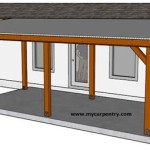How To Build A Rooftop Patio
Constructing a rooftop patio can significantly enhance the value and livability of a property, providing a unique outdoor space for relaxation, entertainment, and enjoyment of panoramic views. However, this project requires careful planning, adherence to building codes, and a thorough understanding of structural requirements. This article outlines the essential steps involved in building a rooftop patio, from initial assessment and design to construction and finishing touches.
1. Initial Assessment and Planning
Before embarking on the construction of a rooftop patio, a comprehensive assessment of the existing building structure is paramount. This assessment typically involves a structural engineer who can evaluate the load-bearing capacity of the roof and determine whether it can safely support the added weight of the patio materials, furniture, and occupants. The engineer will examine the roof’s framing system, including joists, rafters, and supporting walls, to identify any weaknesses or areas that require reinforcement.
Building codes and zoning regulations often dictate specific requirements for rooftop patios, including height restrictions, setback distances from property lines, and safety features such as railings and emergency exits. Researching local building codes and obtaining the necessary permits is crucial to avoid potential legal issues and ensure the patio meets all safety standards. This process may involve submitting architectural plans, structural calculations, and other documentation to the local building department.
The design phase involves considering various factors, including the desired size and layout of the patio, the materials to be used, and any additional features such as outdoor kitchens, fireplaces, or pergolas. The design should take into account the surrounding environment, including views, sun exposure, and wind conditions. It is prudent to create detailed architectural plans and specifications that outline all aspects of the patio construction, including dimensions, materials, and construction methods. These plans will serve as a blueprint for the construction process and ensure that the finished patio meets the desired specifications.
Selecting the appropriate materials for a rooftop patio is essential for both durability and aesthetics. Common materials include pressure-treated lumber, composite decking, concrete pavers, and stone. The choice of materials will depend on factors such as budget, desired appearance, and the level of maintenance required. Pressure-treated lumber is a cost-effective option for framing and decking, while composite decking offers superior resistance to weathering and requires minimal maintenance. Concrete pavers and stone provide a durable and aesthetically pleasing surface, but may require more effort to install.
2. Structural Reinforcement and Weatherproofing
Depending on the results of the structural assessment, it may be necessary to reinforce the roof structure to ensure it can safely support the added weight of the patio. This may involve adding additional joists or rafters, strengthening existing supports, or even replacing the entire roof structure. Working with a structural engineer to design and implement the necessary reinforcements is critical to ensure the safety and integrity of the building.
Proper waterproofing is essential to prevent water damage to the underlying building structure. This typically involves installing a waterproof membrane over the existing roof surface, followed by a drainage system to channel water away from the patio. The waterproof membrane should be durable and resistant to punctures and tears. Common materials include modified bitumen, EPDM rubber, and PVC membranes. The drainage system may consist of sloping the patio surface towards drains or installing a network of drainage channels.
Installing a protective layer over the waterproof membrane is crucial to prevent damage from foot traffic, furniture, and other objects. This layer may consist of a layer of geotextile fabric, a layer of concrete, or a layer of paving stones. The protective layer should be durable and resistant to weathering. It should also be designed to allow water to drain freely without pooling on the surface.
Creating a level surface for the patio is essential for both safety and aesthetics. This may involve leveling the existing roof surface or installing a leveling system. A leveling system typically consists of adjustable pedestals that can be used to create a perfectly level surface, regardless of the slope of the underlying roof. This ensures that furniture and other objects will not wobble or tip over, and that water will not pool on the surface.
3. Construction and Installation
With the structural reinforcement and weatherproofing in place, the next step is to begin the actual construction of the patio. This typically involves building a frame for the patio, installing decking or paving materials, and adding any desired features such as railings, stairs, or outdoor kitchens. The frame should be constructed from pressure-treated lumber or other durable materials and securely fastened to the roof structure. The decking or paving materials should be installed according to the manufacturer's instructions, ensuring that they are properly spaced and aligned.
Railings are an essential safety feature for rooftop patios, particularly those located at significant heights. Railings should be constructed from durable materials such as metal, wood, or composite, and should meet local building code requirements for height and spacing. They should be securely fastened to the patio frame and designed to withstand significant force. The height of the railing is dictated by code; typically, the height is a minimum of 42 inches above the walking surface.
Access to the rooftop patio can be provided by stairs, ladders, or elevators, depending on the design and location of the patio. Stairs should be constructed from durable materials and should meet local building code requirements for rise and run. Ladders should be securely fastened to the building and should be equipped with safety features such as handrails or cages. Elevators provide the most convenient access, but are also the most expensive option.
Electrical and plumbing systems may be required for outdoor kitchens, lighting, or other features. Electrical wiring should be installed by a licensed electrician and should meet all applicable codes. Plumbing lines should be installed by a licensed plumber and should be properly insulated to prevent freezing. Permits are often required for these installations.
4. Finishing Touches and Maintenance
Once the basic construction of the patio is complete, the final step is to add finishing touches such as furniture, landscaping, and lighting. The choice of furniture will depend on the desired style and function of the patio. Outdoor furniture should be durable and resistant to weathering. Landscaping can add a touch of nature to the rooftop patio and can provide shade and privacy. Lighting can enhance the ambiance of the patio and can provide safety and security.
Regular maintenance is essential to keep a rooftop patio in good condition. This may involve cleaning the surface, inspecting the waterproof membrane, and repairing any damage. The surface should be cleaned regularly to remove dirt, debris, and stains. The waterproof membrane should be inspected regularly for punctures, tears, or other damage. Any damage should be repaired promptly to prevent water damage to the underlying building structure. Regular power washing can remove mold and mildew.
Seasonal maintenance tasks may include removing snow and ice in the winter and protecting furniture from the elements. Snow and ice can add significant weight to the roof structure and can damage the patio surface. Furniture should be covered or stored during the winter months to protect it from the elements.
Safety inspections should be conducted regularly to ensure that the patio is safe for use. This may involve inspecting railings, stairs, and electrical and plumbing systems. Any potential hazards should be addressed promptly to prevent accidents. Implementing these safety checks will minimize the risks associated with a rooftop patio.

Building A Rooftop Deck 6 Steps To Success

Building A Rooftop Deck 6 Steps To Success

Building A Roof Deck Fine Homebuilding

Rooftop Terrace Decks All Decked Out

Decking Over A Roof Fine Homebuilding

Building A Roof Deck Landis Architects Builders

How To Build A Rooftop Deck Wausau Tile

Building A Rooftop Deck Costs And Materials Trex

Patio Cover Plans Build Your Or Deck

The Pros And Cons Of Rooftop Decks Deck Bros
Related Posts








